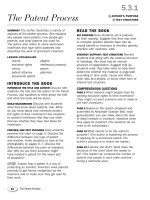4 6 1 the womens movement (social studies)
Bạn đang xem bản rút gọn của tài liệu. Xem và tải ngay bản đầy đủ của tài liệu tại đây (4.82 MB, 14 trang )
Suggested levels for Guided Reading, DRA,™
Lexile,® and Reading Recovery™ are provided
in the Pearson Scott Foresman Leveling Guide.
Genre
Expository
nonfiction
Comprehension
Skills and Strategy
• Cause and Effect
• Draw Conclusions
• Answer Questions
Text Features
•
•
•
•
Captions
Diagram
Map
Glossary
Scott Foresman Reading Street 4.6.1
ISBN 0-328-13489-9
ì<(sk$m)=bdeijc< +^-Ä-U-Ä-U
by Lara Bove
Reader Response
Tto theheone below, show what
1. Using a chart similar
Women’s
Movement
caused suffragists to be jailed. What were some
effects of suffragists being jailed?
Cause
Effect
2. What were bloomers? How can you find out more
about bloomers?
3. Look through the book and find examples of
verbs ending in –ing. Choose two sentences with
–ing words and try to rewrite them without using
–ing.
4. Use the map on pages 12 and 13 to find out which
states allowed women to vote between 1890
and 1900.
by Lara Bove
Editorial Offices: Glenview, Illinois • Parsippany, New Jersey • New York, New York
Sales Offices: Needham, Massachusetts • Duluth, Georgia • Glenview, Illinois
Coppell, Texas • Ontario, California • Mesa, Arizona
Women’s Suffrage
Every effort has been made to secure permission and provide appropriate credit for
photographic material. The publisher deeply regrets any omission and pledges to
correct errors called to its attention in subsequent editions.
Unless otherwise acknowledged, all photographs are the property of Scott Foresman,
a division of Pearson Education.
Photo locators denoted as follows: Top (T), Center (C), Bottom (B), Left (L), Right (R),
Background (Bkgd)
Opener: Library of Congress; 1 Library of Congress; 4 Getty Images, Library of
Congress; 5 Getty Images; 7 © Bettmann/Corbis; 9 Library of Congress, Getty Images;
10 Library of Congress, Getty Images; 11 AP/Wide World, Library of Congress;
15 Image Works, Inc., PunchStock; 17 Library of Congress; 19 AP/Wide World;
20 Comstock, Getty Images; 21 Corbis Media; 22 Stockbyte, Brand X Pictures
ISBN: 0-328-13489-9
Copyright © Pearson Education, Inc.
All Rights Reserved. Printed in the United States of America. This publication is
protected by Copyright, and permission should be obtained from the publisher
prior to any prohibited reproduction, storage in a retrieval system, or transmission
in any form by any means, electronic, mechanical, photocopying, recording, or
likewise. For information regarding permission(s), write to: Permissions Department,
Scott Foresman, 1900 East Lake Avenue, Glenview, Illinois 60025.
2 3 4 5 6 7 8 9 10 V0G1 14 13 12 11 10 09 08 07 06 05
Voting rights among men and women have not
always been equal. While many white men have
always had the right to vote, women’s voting rights
have been restricted in terms of where they could
vote and in which elections. In 1869 women could
vote in Wyoming. At that time Wyoming was only a
territory. It became a state in 1890 and gave women
full voting rights, including voting for President of
the United States. Soon other western states such as
Colorado, Idaho, and Utah gave women the right to
vote too.
In other states women could vote in some local
elections. In 1920 the Nineteenth Amendment to the
U.S. Constitution
became law. An
amendment is an
addition. This one
gave women the
right to vote in all
elections.
Women and some
men worked hard to
make voting rights
equal for everyone.
Their work is known
as the women’s
suffrage movement.
Suffrage is the right
to vote.
Women vote in Wyoming Territory
3
Seneca Falls
The women’s suffrage movement began in Seneca
Falls, New York. The year was 1848, and Elizabeth
Cady Stanton and Lucretia Mott, two leaders in
women’s rights, organized a meeting. They put a
notice in the newspaper to let people know about the
meeting. They called it a women’s rights convention.
The Women’s Rights Convention took place over
two days, and three hundred people attended. Many
women who came brought their husbands with them.
A few women suffragists read speeches. Frederick
Douglass, an enslaved man who had escaped to
freedom, also spoke. He was a powerful speaker
active in the fight to end slavery. Douglass spoke
strongly in support of women’s rights.
The newspapers covered the convention, but the
stories were not favorable. In general, Americans
at that time did not think women should be voting,
and this included most
women. Many American
women saw their role
as being mothers and
wives. They did not
think that they needed
to vote.
Elizabeth Cady Stanton
4
At the end of the two days, the convention passed
many resolutions, or goals, that the women wanted
to achieve. One goal was that women should have
the right to vote. Since laws affected women and
men alike, women wanted to take part in electing
the people who passed the laws. They would have to
work hard to make this possible.
These people
signed the
Declaration of
Sentiments at
the Women’s
Rights Convention
in Seneca Falls,
New York.
5
Clothing
In the 1800s fashion was strict. The clothes
women wore made it difficult for them to do their
work, and they worked hard. Women cooked on
wood and coal stoves. They collected wood, put it in
the stove, and made a fire. They waited for the fire
to get hot enough for them to cook. As they cooked,
they added wood to keep the fire hot.
Women had to wash clothing by hand. Some
women had water pumps, but others had to carry
water from a well or stream to do their washing. They
used a washboard and scrubbed the clothing by hand.
Women also sewed clothing for their families, and
many worked on family farms.
Women wore long, heavy dresses with petticoats
underneath. Because women’s fashion was so
cumbersome and got in the way of their work, some
women thought wearing bloomers would make
their work easier. Bloomers were long, baggy pants
gathered at the ankle. Bloomers were named after
Amelia Bloomer, who edited a magazine called The
Lily. In her magazine she described the new clothes,
saying they were more comfortable for gardening and
caring for her children.
Elizabeth Cady Stanton loved bloomers. She said
that women needed more freedom with their attire.
Bloomers gave women more freedom to move about.
Today it seems silly that people would have been
upset by women wearing bloomers, but they were. In
fact the activists gave up wearing bloomers by 1854
because they did not want people to focus on what
they were wearing. They wanted people to listen to
what they were saying. Since they were asking for the
right to vote, women knew they needed voting men
to give them that right.
This woman is wearing bloomers.
6
7
Slavery And
The Women’s Movement
In the early 1800s there were more serious
problems than the clothing women wore. Slavery was
still legal in half the country.
Many of the women’s rights activists were also
abolitionists. This means they believed slavery
should be abolished, or stopped. A woman named
Sojourner Truth had been an enslaved person. She
had escaped to New York and become a leader in the
fight to end slavery. Though she could not read or
write, she was a powerful speaker.
In 1851 Sojourner Truth spoke at a women’s rights
convention in Ohio. No one wrote down her words
while she spoke. Later someone wrote it down from
memory. In her speech titled “Ain’t I a Woman?” she
said that if a man says women should be helped into
carriages, lifted over ditches, and given the best of
everything, why hasn’t she been helped.“Ain’t I a
woman?” she asked.
Sojourner Truth continued to support women’s
rights. In 1853 she spoke in New York City. This
time many rivals and opponents came. They sat in
the meeting, making a lot of noise so no one could
hear the speakers. Sojourner Truth put them in their
place. She spoke to them, telling them they could not
stop the women’s movement, and she promised that
women would get their rights.
Sojourner Truth
8
9
People Who Made It Happen
Susan B. Anthony
Alice Paul
In 1872 Susan B. Anthony voted illegally. Three
weeks later, on Thanksgiving Day, a federal marshal
came to her home and arrested her. She was released
after her lawyer posted bail, but at her trial she was
found guilty. She was fined one hundred dollars.
Anthony refused to pay the fine, and the government
never tried to collect it.
Alice Paul grew up in a Quaker home. She went
to college and earned many advanced degrees. That
level of education was unusual for anyone at the time.
In 1906 Paul went to England where she joined the
women’s suffrage movement and was jailed three
times for her beliefs. In 1909 she came back to the
United States, became a suffragist leader, and led
marches and other protests. She went to jail three
more times and even staged a hunger strike in jail.
Lucy Stone
Lucy Stone married Henry Blackwell in 1855. She
did not take his last name, which was rarely done in
the 1850s. In fact she could not sign legal documents
as Lucy Stone. Stone was ahead of her time in other
ways. She said she would not pay taxes on her home
since she couldn’t vote. She said it was taxation
without representation. The state took some of her
furniture as payment for the taxes.
Lucy Stone
10
Lucretia Mott
Lucretia Mott grew up in Boston, Massachusetts, and
became a teacher. Her interest in the women’s rights
movement first began when she learned that she would
be paid half the salary that a male teacher would be paid.
Mott also worked to end slavery. She and her husband
helped many runaway slaves along the Underground
Railroad, a network of safe places for enslaved people to
stay as they escaped north to freedom.
Alice Paul
Lucretia Mott
11
A Movement Tested
And Divided
In the 1850s Americans were afraid a war would
break out. They did not want to think about women’s
rights. They were thinking about slavery and war.
The Civil War began in 1861, when Abraham
Lincoln was President. President Lincoln made a deal
with the suffragists, promising to support them after
the war. The war ended in 1865, and a few days later,
President Lincoln was killed. Andrew Johnson became
president, but he did not support women’s rights.
Many suffragists lost hope in the federal
government. Things got even worse when the leaders
of the women’s rights movement ended up forming
two different groups. Lucy Stone started the American
Woman Suffrage Association (AWSA). Elizabeth Cady
Stanton and Susan B. Anthony started the National
Woman Suffrage Association (NWSA).
The AWSA had both women and men as members.
They worked at the state level, trying to get each state
to grant suffrage to women. The NWSA was thought
of as a more extreme organization than the AWSA.
It allowed only women as members, and it sought
to change federal laws. The NWSA felt it was more
effective to focus on
passing federal laws,
rather than trying
to change laws in
each state.
Year women were
given the right to vote
1890–1900
1901–1910
1911–1919
1920
12
13
The NWSA
The NWSA held its first meeting in 1869. In
Washington, D.C., Susan B. Anthony asked Congress
to pass a sixteenth amendment to the Constitution
which would give women the right to vote. Soon it
was being called the Susan B. Anthony Amendment.
Congress considered the amendment in 1878, nine
years after Anthony first asked for it. When Senator
Sargent, from California, introduced the amendment,
it did not pass.
The women, however, did not give up. They
traveled all across the country making speeches,
leading marches, and circulating petitions. Because
there were no radios or televisions in the late 1800s,
people could not hear or see the speakers unless they
went in person. Without planes, cars, or sometimes
even paved roads, the suffragists traveled by horsedrawn carriages and on trains. They did not let the
difficulty of travel stop them because they believed
so strongly in their cause.
The AWSA and the NWSA merged into one group
in 1890, and this time the group was called the
National American Woman Suffrage Association
(NAWSA). Elizabeth Cady Stanton was its first
president.
How an Amendment to
the Constitution Is Ratified
1
An amendment goes to
the House of Representatives.
Two-thirds of the representatives
must pass it. If they do not,
it stops there.
2
If it passes in the House,
it goes to the U.S. Senate.
Two-thirds of the senators must
pass it. If they do not, it stops
there.
3
If it passes in the Senate, it
goes to the state legislatures.
Three-fourths of the legislatures
must pass it. If they do not, it is
rejected.
There were only forty-eight states in 1920. Today there are fifty
states. So today it takes thirty-eight states to ratify, or approve,
an amendment.
14
15
Signs of Success
As you know, in Wyoming, women could vote
beginning in 1869, when Wyoming was a territory.
When Wyoming became a state in 1890, it was the first
state with women’s suffrage. Three years later, Colorado
gave women voting rights. Carrie Chapman Catt, an
active suffragist, worked to get women’s suffrage in the
West, and she succeeded in Utah and Idaho.
Though it took a few years, several other western
states gave women voting rights as well. Women
got voting rights in Washington State in 1910. The
next year women in California got the vote. Oregon,
Arizona, and Kansas passed women’s suffrage in 1912.
Women’s suffrage parade,
New York City, 1912
16
The suffragists held parades in New York City
and Washington, D.C. Thousands of people marched
in one parade in New York City. Sadly, some of the
spectators caused some trouble for the people
marching in the parade. A crowd of people in the
middle of the street would not let the marchers
pass. The crowd yelled and spit at the marchers, and
they even tripped and shoved them. One hundred
marchers ended up in the hospital, but the police
did not do anything. All of this was printed in the
newspapers.
In 1914 World War I began. The suffragists did
not want to see the war stop their movement. They
had waited during the Civil War, and when that war
ended, they got nothing. So this time they persevered.
President Woodrow Wilson ran for a second term in
1916. He made campaign promises to keep the United
States out of the war.
Wilson also promised Carrie Chapman Catt that he
would support women’s suffrage, but it was not his
priority. Nevertheless, he gained women’s support.
Wilson apparently did fairly well
with female voters in the dozen or
so states that allowed women to
vote in 1916.
17
Picketing at the White House
Soon women began picketing in front of the White
House. Their first picket was on January 10, 1917, and
after that they came almost every Monday through
Saturday. The women picketed in all kinds of weather.
In the beginning, President Wilson treated them quite
well. He smiled as he drove by them and offered them
coffee on cold days.
In April 1917 the United States officially declared
war on Germany, and once again, people asked the
suffragists to wait for the war to end. They would
not wait. They continued their daily pickets at the
White House.
By June 1917 the President was not as friendly
with the picketers. When he had Russian diplomats
visiting, the marchers carried a banner that
embarrassed him. It said that the United States was
not a democracy. After all, women couldn’t vote.
Wilson said that the women had to stop picketing,
and if they did not they would be arrested. The
women’s leader, Alice Paul, consulted with lawyers,
who said the women had a legal right to picket. The
women continued to picket, and in November 1917,
150 women were arrested and taken to jail.
Because the women could not be charged with
picketing, which was a legal activity, they were
charged with obstructing traffic. The women were
found guilty and were fined twenty-five dollars each.
They chose to serve three days in jail rather than
pay the fine.
Less than a week later, the pickets began again.
The women were again arrested. In the end these
women also spent three days in jail.
Women picket for their rights
in front of the White House.
18
19
Prisoners Gain Public Support
The women continued to picket, and things got
much worse. The police continued to arrest them,
and the judges gave harsher sentences. By the fall
some women were sent to jail for sixty days.
The conditions in jail were horrific. The women
were treated roughly, even abused, and their food was
rotten and sometimes had worms inside.
This did not seem to change the attitude of
politicians, since people who picketed for this
cause were still being arrested. Suffragists worked
hard to let the public know how badly they were
being treated, and people became more and more
sympathetic to the cause.
At the end of November 1917, the prisoners were
all released, but the suffragists still had not completed
their task.
In January 1918 the House passed the Susan
B. Anthony Amendment, but it did not pass in the
Senate. Another year would go by before that would
happen.
The suffragists did not give up. They held more
protests in August 1918. The police arrested them,
and the newspapers showed pictures of the prisoners.
The women began wearing black armbands. They
were saying that justice was dead.
The amendment finally passed in both the House
and the Senate in June 1919. The women still had
a lot of work to do. They needed thirty-six states to
ratify, or approve, the amendment.
The first three states passed the amendment in
June 1919. Those states were Wisconsin, Illinois, and
Michigan. The last state to pass the amendment was
Tennessee, on August 18, 1920. Women had finally
won the right to vote. It was a long struggle—only
one woman who had attended the Seneca Falls
convention was still alive. Charlotte Woodward was
the only one to live to see the dream become reality.
Women celebrate
their right to vote.
20
21
Now Try This
Be an Activist
An activist is someone who tries to change society
or government. Because many people do not like
change, activists are not always popular. Activists,
however, can be recognized for their courage.
An activist does three things:
1. Makes people aware of an issue.
2. Helps people see that change is needed.
3. Convinces the leadership to make the change.
22
to Do It!
w
o
H
s
’
e
r
He
1. Think of an issue that is important to you. You
might want to improve education for the poor.
You might want to help care for homeless people.
Or you may have another entirely different idea.
2. Look back at the three activist steps on page 22.
Then think about and write down your answers to
these questions.
• Who are you trying to make aware of the issue?
How will you make them aware?
• Why is change needed? How can you help people
see this?
• What leaders need to be convinced? How will you
do this?
3. How will things be better if your changes are
made? Write a paragraph describing how the
world will be better.
4. Make a plan of action. Outline the steps you will
take to change your classroom or world. Then put
your plan into action!
23
Glossary
Reader Response
abolitionists n. people
who actively tried to
end slavery.
spectators n. people
who are watching an
event.
attire n. clothing; what
a person wears.
suffrage n. the right to
vote.
cumbersome adj.
difficult to deal with.
suffragists n. people
who actively tried to
get women the right to
vote.
rivals n. people who
want and try to get the
same thing as another
or do better than
another; competitor.
1. Using a chart similar to the one below, show what
caused suffragists to be jailed. What were some
effects of suffragists being jailed?
Cause
Effect
2. What were bloomers? How can you find out more
about bloomers?
3. Look through the book and find examples of
verbs ending in –ing. Choose two sentences with
–ing words and try to rewrite them without using
–ing.
4. Use the map on pages 12 and 13 to find out which
states allowed women to vote between 1890
and 1900.
24









